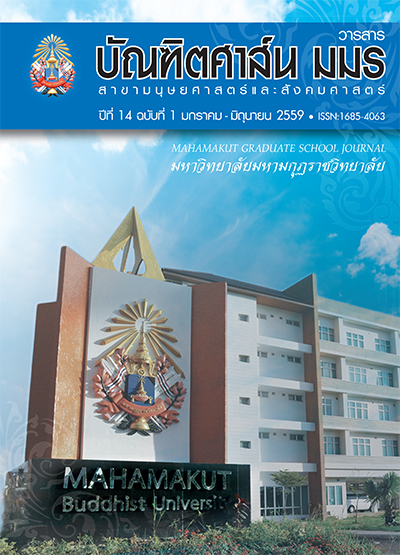ศึกษาวิเคราะห์กระบวนการขัดเกลากิเลสที่ปรากฏในสัลเลขสูตร
บทคัดย่อ
การวิจัยครั้งนี้ มีวัตถุประสงค์เพื่อ 1) เพื่อ ศึกษากิเลสที่ปรากฏในสัลเลขสูตร 2) เพื่อศึกษา กระบวนการขัดเกลากิเลสที่ปรากฏในสัลเลขสูตร และ 3) เพื่อวิเคราะห์คุณค่าและประโยชน์ของ กระบวนการขัดเกลากิเลสที่ปรากฏในสัลเลขสูตร ผู้วิจัยได้เก็บรวบรวมข้อมูลจากคัมภีร์พระไตรปิฎก เป็นเอกสารหลัก อรรถกถา หนังสือตำราวิชาการ และเอกสารที่เกี่ยวข้อง
ผลการวิจัยปรากฏว่า กิเลสในสัลเลขสูตร เป็น ธรรมชาติที่ส่งผลให้เกิดการเร่าร้อน เศร้าหมอง เป็นทุกข์ ได้หมักดองอยู่ในสันดานมนุษย์ จะฟุ้งขึ้น มาเมื่อเกิดการกระทบกันของอายตนะภายในและ ภายนอกที่เป็นอกุศลธรรม ในที่นี้มีกิเลส 44 ชนิด คือ การเบียดเบียน 1, อกุศลกรรมบถ 10, มิจฉัตตะ 9, นิวรณ์ 5 (ผู้มักเพ่งเล็งและพยาบาทอยู่ในอกุศล กรรมบถ 10), อุปกิเลส 13,อสัทธรรม 7 และยึดติด ทิฏฐิของตน 1 เกิดและดับอยู่ตลอดเวลา
การขัดเกลากิเลส เป็นกระบวนการ วิธีการที่ บรรเทา ทำลายกิเลสที่ฟุง้ ขึ้นทั้ง 44 ชนิด ดว้ ยใชห้ ลัก ธรรมขัดเกลาให้กิเลสเบาบางถึงกับหมดไป คือ การ ไม่เบียดเบียน ขัดเกลากิเลส การเบียดเบียน, กุศล กรรมบถ 10 ขัดเกลาอกุศลกรรมบถ 10, สัมมัตตะ 9 ขัดเกลามิจฉัตตะ 9, ความไม่หดหู่ ไม่เซื่องซึม ไม่ฟุ้งซ่าน ร้อนใจ ไม่ลังเลสงสัย ขัดเกลานิวรณ์ 5, ขัดเกลาอุปกิเลส 13, สัทธรรม 7 ขัดเกลาอสัทธรรม 7 และไม่ยึดติดทิฏฐิของตน ขัดเกลาการยึดติดทิฏฐิ ของตน ได้ส่งเสริมให้คุณธรรมเพิ่มพูนในจิตใจยิ่ง ขึ้น จึงใช้หลักธรรมช่วยอีก 44 หลักธรรมด้วยกัน เช่น กิเลสชนิด การเบียดเบียน เป็นการละเมิดทาง กายและทางวาจา หลักธรรมขัดเกลา คือ การไม่ เบียดเบียน เปน็ การไมล่ ะเมิดผูอื้่นดว้ ยกายและวาจา หลักธรรมที่ส่งเสริม คือ ความกรุณา ทำให้จิตใจอ่อน โยน อยากใหผู้อื้่นพน้ ทุกข ์ เปน็ ตน้ และจัดกิเลสออก เป็น 3 ระดับ คือ กิเลสอย่างหยาบ กิเลสอย่างกลาง และกิเลสอย่างละเอียด ได้นำหลักไตรสิกขา คือ อธิสีลสิกขา อธิจิตตสิกขา และอธิปัญญาสิกขา มา อบรม ปฏิบัติในการขัดเกลากิเลสทั้ง 3 ระดับ
คุณค่าและประโยชน์ที่ได้จากการขัดเกลา กิเลส มี 1. คุณค่าและประโยชน์ต่อการบรรลุธรรม ทำให้เป็นพระอริยบุคคลระดับต่างๆ 2. คุณค่า และประโยชน์ต่อบุคคล ทำให้ กาย วาจาและใจ แสดงออกในทางสุจริต อย่างสุภาพ อ่อนโยนมีเมตตา กรุณา และมีสติปัญญาแก้ปัญหาได้อย่างถูกต้อง และ 3. คุณค่าต่อสังคมทำให้เศรษฐกิจ การเมือง และ สังคมสงบสุข
เอกสารอ้างอิง
มหาเถรสมาคม. (2549). พระไตรปิฎก ภาษาไทย ฉบับเฉลิมพระเกียรติพระบาทสมเด็จพระเจ้าอยู่หัว เนื่องในการจัดงานฉลองสิริราชสมบัติครบ 30 ปี พ.ศ. 2549. (เล่มที่ 4, 7, 8, 9, 10, 11, 12, 13, 14, 15, 16, 17, 18, 19, 20, 21, 22, 23, 24, 25, 26, 27, 28, 29, 30, 31, 34, 35, 37). กรุงเทพฯ: อมรินทร์พริ้นติ้งแอนด์พับลิชชิ่ง.
มหามกุฏราชวิทยาลัย, มูลนิธิ. (๒๕๓๖).พระไตรปิฎกและอรรถกถาแปลฉบับมหามกุฏราชวิทยาลัย (91 เล่ม). พิมพ์เนื่องในวโรกาสครบ 200 ปี แห่งพระราชวงศ์จักรี กรุงรัตนโกสินทร์พุทธศักราช 2525. (เล่มที่ 11, 17, 45). (พิมพ์ครั้งที่ 3). กรุงเทพฯ: โรงพิมพ์มหามกุฏราชวิทยาลัย.
ข้อมูลทุติยภูมิ
1) หนังสือทั่วไป
พ. สถิตวรรณ (พระธรรมวิสุทธิกวี วัดโสมนัสวิหาร). (2551).อุปกิเลส 16 สนิมในใจ (เล่ม 1).กรุงเทพฯ: ชวนพิมพ์ 50.
พ. สถิตวรรณ. (พระธรรมวิสุทธิกวี วัดโสมนัสวิหาร). (2550).อุปกิเลส 16 สนิมในใจ (เล่ม 2). (พิมพ์ครั้งที่ 2). กรุงเทพฯ: ชวนพิมพ์ 50.
พระพุทธโฆสเถระ รจนา. (2555). คัมภีร์วิสุทธิมรรค ภาษาไทย ภาค 1 ฉบับมหาวิทยาลัยมหาจุฬาลงกรณราชวิทยาลัย. โรงพิมพ์มหาจุฬาลงกรณราชวิทยาลัย. (2555). คัมภีร์วิสุทธิมรรค ภาษาไทย ภาค 2 ฉบับมหาวิทยาลัยมหาจุฬาลงกรณราชวิทยาลัย. โรงพิมพ์มหาจุฬาลงกรณราชวิทยาลัย.
พระธรรมโกศาจารย์ (พุทธทาสภิกขุ).(ม.ป.ป.). การเก็บความโกรธใส่ยุ้งฉาง. กรุงเทพฯ: ธรรมสภา.
พระธรรมปิฎก (ป.อ. ปยุตฺโต). (2545). พุทธรรม ฉบับเดิม. กรุงเทพฯ: ธรรมสภา.
พระธรรมปิฎก. (2545). พจนานุกรมพุทธศาสน์. กรุงเทพฯ: บริษัท สหธรรมิก จำกัด.
พระพรหมคุณาภรณ์ (ป.อ. ปยุตฺโต). (2555). พุทธรรม ฉบับปรับขยาย. กรุงเทพฯ: ผลิธัมม์.
พระพรหมคุณาภรณ์ (ป.อ. ปยุตฺโต). (2556). พจนานุกรมพุทธศาสน์ ฉบับประมวลศัพท์.(พิมพ์ครั้งที่ 19). กรุงเทพฯ: ธรรมสภา.
พระพรหมคุณาภรณ์ (ป.อ. ปยุตฺโต). (2558). พจนานุกรมพุทธศาสน์ฉบับประมวลธรรม.(พิมพ์ครั้งที่ 30). กรุงเทพฯ: ผลิธัมม์.
ราชบัณฑิตยสถาน. (2556). พจนานุกรมฉบับราชบัณฑิตยสถาน 2554. (พิมพ์ครั้งที่ 2). กรุงเทพฯ: นานมีบุ๊คส์พับ
ลิเคชั่นส์.
สมเด็จพระญาณสังวร สมเด็จพระสังฆราช สกลมหาสังฆปริณายก. (2552). ธรรมาภิธานพจนานุกรมคำสอนพระพุทธศาสนา. คณะรัฐบาลจัดพิมพ์.
2) วิทยานิพนธ์/สารนิพนธ์
เจ้าอธิการทองใบ อมโร. (2553). การศึกษาหลักธรรมที่นำไปปฏิบัติเพื่อการหลุดพ้นกิเลสในพระพุทธศาสนาเถรวาท. วิทยานิพนธ์พุทธศาสตรมหาบัณฑิต, บัณฑิตวิทยาลัย, มหาวิทยาลัยมหาจุฬาลงกรณราชวิทยาลัย.
พระมหากิตติศักดิ์ กิตฺติวฑฺฒโน (ช่างทอง). (2554). ศึกษาวิเคราะห์มัจฉริยะในพระพุทธศาสนาเถรวาท. วิทยานิพนธ์พุทธศาสตรมหาบัณฑิต, บัณฑิตวิทยาลัย, มหาวิทยาลัยมหาจุฬาลงกรณราชวิทยาลัย.
ดาวน์โหลด
เผยแพร่แล้ว
รูปแบบการอ้างอิง
ฉบับ
ประเภทบทความ
สัญญาอนุญาต
บทความวิชาการและบทความวิจัยในวารสารฉบับนี้ถือเป็นความรับผิดชอบของผู้เขียนเท่านั้น บทความที่ได้รับการตีพิมพ์ในวารสารบัณฑิตศาส์น ถือเป็นลิขสิทธิ์ของมหาวิทยาลัยมหามกุฏราชวิทยาลัย ตามพระราชบัญญัติลิขสิทธิ์



